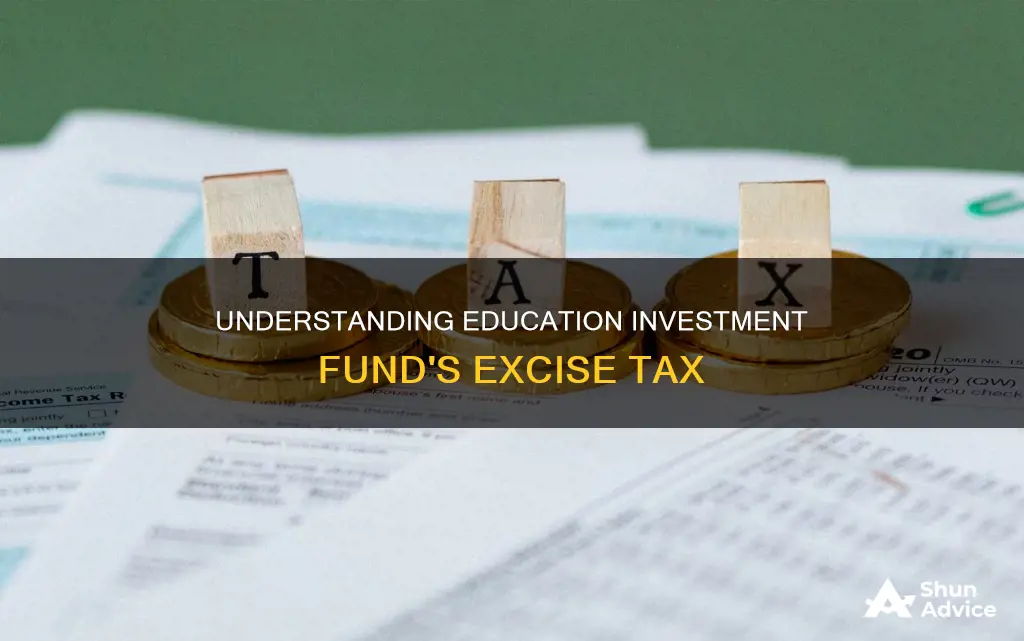
The excise tax on net investment income of certain private colleges and universities is a 1.4% tax on the net investment income of applicable educational institutions. The net investment income is determined using rules similar to the rules for the net investment income of private foundations.
Applicable educational institutions are those with at least 500 tuition-paying students, more than 50% of whom are located in the US, and with assets (other than those used directly in carrying out the institution's exempt purpose) with an aggregate fair market value of at least $500,000 per student.
| Characteristics | Values |
|---|---|
| Type of tax | Excise tax |
| Tax rate | 1.39% |
| Tax base | Net investment income |
| Taxable entities | Private foundations |
What You'll Learn

The excise tax on net investment income of certain private colleges and universities
The US Internal Revenue Service (IRS) imposes an excise tax on the net investment income of certain private colleges and universities. This tax is applied at a rate of 1.4% and affects private colleges and universities with at least 500 tuition-paying students (more than half of whom are located in the US) and assets of at least $500,000 per student. The tax base is calculated as the excess of a college or university's gross investment income and capital gain net income over its allowable deductions. Gross investment income includes interest, dividends, rents, royalties, and payments with respect to securities loans. Notably, unrelated business taxable income is excluded from gross investment income as it is subject to unrelated business income tax.
Capital gain net income is determined using traditional capital gain rules, but gains or losses from property used for the foundation's exempt purpose for at least a year are also excluded. Allowable deductions include expenses incurred for the production or collection of gross investment income or for the management of property held for income production, such as officer compensation, employee wages, professional fees, interest, rent, and taxes. Charitable contributions, net operating losses, and special corporate deductions are not allowed as deductions.
The tax rate for net investment income is 1.39% for tax years beginning after December 20, 2019, as legislated by the Further Consolidated Appropriations Act of 2020. This rate applies to private foundations, which are defined as having public support for the past 10 taxable years, with no more than 25% of the governing body comprising disqualified persons and no officers being disqualified. Prior to this legislation, the tax rate was 2% and could be reduced to 1% under certain conditions.
Net investment income excise tax is reported in Part V of Form 990-PF and must be filed by the 15th day of the fifth month following the end of the foundation's tax year, or the 11th month if an extension is obtained. If the tax owed is under $500, a single payment can be made with the Form 990-PF filing. If the tax is $500 or more, estimated installment payments are required, calculated using Form 990-W, and paid electronically through the Electronic Federal Tax Payment System. Late payments are subject to a penalty of 0.5% of the unpaid tax per month, up to 25% of the total tax.
Best Mutual Funds to Invest in the USA
You may want to see also

The definition of student
The definition of a student, as per the IRS, is a person who meets all of the following requirements:
- The student did not have expenses that were used to figure an American opportunity credit in any 4 earlier tax years.
- The student had not completed the first 4 years of postsecondary education (generally, the freshman, sophomore, junior, and senior years of college) before 2023. Any academic credit awarded solely on the basis of the student's performance on proficiency examinations is disregarded in determining whether the student has completed 4 years of postsecondary education.
- For at least one academic period beginning in 2023 (or the first 3 months of 2024 if the qualified expenses were paid in 2023), the student was enrolled at least half-time in a program leading to a degree, certificate, or other recognized educational credential. The standard for what is half of the normal full-time workload is determined by each eligible educational institution. However, the standard may not be lower than any of those established by the U.S. Department of Education under the Higher Education Act of 1965.
- The student has not been convicted of any federal or state felony for possessing or distributing a controlled substance as of the end of 2023.
To be considered an eligible student, one must be pursuing a program leading to a degree or other recognised educational credential and be enrolled at least half-time for at least one academic period that begins during 2023 (or the first 3 months of 2024 if the qualified expenses were paid in 2023).
Invest Wisely: Graphene Mutual Funds for Beginners
You may want to see also

The definition of tuition-paying
Tuition-paying refers to the fees charged by educational institutions for instruction or other services. These fees are usually known as 'tuition' in American English and 'tuition fees' in Commonwealth English. Tuition-paying is one of the two largest revenue sources for educational institutions in some countries, the other being public spending.
Tuition-paying is required for all forms of education, including primary, secondary, and post-secondary education. The cost of tuition can vary depending on the level of education, the type of institution, and the location. In some countries, such as those in Scandinavia and Continental Europe, there are no or only nominal tuition fees for all forms of education. In other countries, such as the United States, the United Kingdom, and South Africa, tuition fees can be substantial and may require students to take out loans or seek grants and scholarships.
Tuition-paying can be covered through various methods, including company sponsorship, government student loans, private funding, or family money. In the United States, there are also tax benefits available to help offset the cost of tuition, such as the American Opportunity Credit and the Lifetime Learning Credit.
Stable Value Funds: A Safe Investment Option for Families
You may want to see also

The definition of located in the United States
The United States of America (USA), commonly known as the United States (U.S.) or America, is a country located primarily in North America. It is a federal union of 50 states and a federal capital district, Washington, D.C. The 48 contiguous states border Canada to the north and Mexico to the south, with the states of Alaska to the northwest and the archipelagic Hawaii in the Pacific Ocean. The United States also asserts sovereignty over five major island territories and various uninhabited islands.
The United States is the world's third-largest country by total area, with a total area (excluding coastal and territorial water) of 3,677,649 square miles (9,525,067 square kilometres). The country's coastal and territorial waters cover 1,114,056 square miles (2,885,483 square kilometres).
The United States is the world's third-most populous country, with a population of over 334 million. The country's population is predominantly urban, with about 82% of people living in urban areas. The United States is ethnically diverse, with its population deriving from various countries and ethnicities around the world.
The United States is a federal republic with three branches of government: the legislative, executive, and judicial. The country's head of state and government is the President, who is elected indirectly through an Electoral College system. The President serves a four-year term and can be re-elected once.
The United States has the world's largest economy by nominal GDP and the second-largest by PPP. The country has a highly developed mixed economy, with the world's largest consumer market and third-highest per capita GDP. The United States has the most technological and industrial innovations, with advancements in artificial intelligence, electronics, computers, pharmaceuticals, and medical, aerospace, and military equipment.
The United States is a founding member of the World Bank, Organisation of American States, NATO, and the United Nations, as well as a permanent member of the UN Security Council.
International Funds: Worth the Investment Risk?
You may want to see also

The definition of assets used directly in carrying out an institution's exempt purpose
> An asset is used (or held for use) for exempt purposes only if it is actually used by the foundation in carrying on the charitable, educational, or similar function that gives rise to its exempt status, or if the foundation owns the asset and establishes to the satisfaction of the Service that its immediate use in exempt functions is not practical and that definite plans exist to begin the use within a reasonable period of time.
Assets that are used directly in carrying out an institution's exempt purpose include:
- Administrative assets, such as office equipment and supplies, used by foundation employees and consultants to the extent these assets are devoted to and used directly in the administration of exempt activities
- Real estate or the part of a building used by the foundation directly in its exempt activities
- Physical facilities used in exempt activities such as paintings or other works of art owned by the foundation on public display, classroom fixtures and equipment, and research facilities and related equipment which, under the facts and circumstances, serve a useful purpose in the conduct of the exempt activities
- Any interest in a functionally related business, or in a program-related investment
- The reasonable cash balances necessary to cover current administrative expenses and other normal and current disbursements directly connected with the foundation's charitable, educational, or other similar exempt activities
- Any property leased by a foundation in carrying out its exempt purpose at no cost, or at a nominal rent, to the lessee or for a program-related purpose such as the leasing of renovated apartments to low-income tenants at a low rental as part of the lessor-foundation's program for rehabilitating a blighted area of a community
However, assets held for the production of income or for investment (e.g. stocks, bonds, interest-bearing notes, endowment funds, or generally, leased real estate) are not considered used or held for use for exempt purposes even though the income from those assets is used to carry out an exempt purpose.
American Funds: Worth Your Investment?
You may want to see also
Frequently asked questions
The Internal Revenue Service (IRS) imposes an excise tax on the net investment income of certain private colleges and universities. The tax applies to any private college or university that has at least 500 full-time tuition-paying students (more than half of whom are located in the US) and that has assets other than those used in its charitable activities worth at least $500,000 per student. The tax rate is 1.4% as of 2019.
NII is the sum of gross investment income and capital gain net income less allocable deductions. Gross investment income includes income from interest, dividends, rents, payments with respect to securities loans, and royalties. However, it does not include income that is considered unrelated business taxable income (UBTI).
UBTI is income from trades or businesses regularly carried on by a tax-exempt entity that is unrelated to the entity's tax-exempt purpose.







